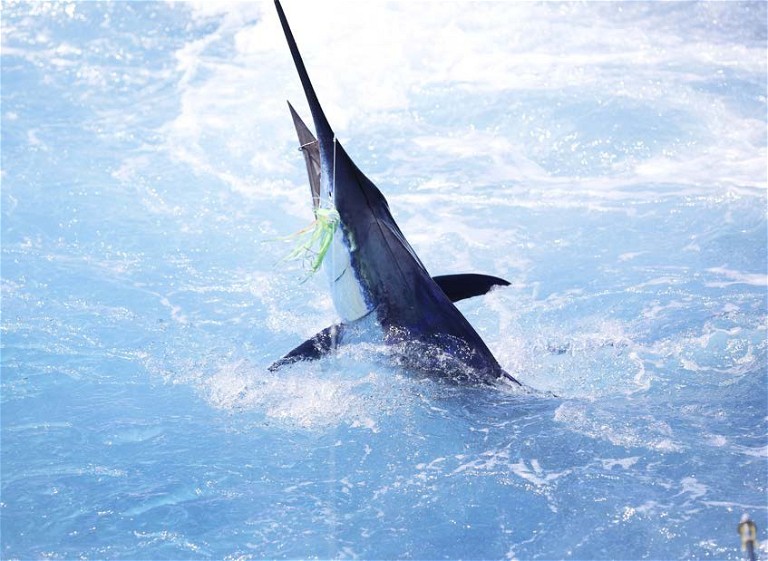THE THREE KINGS ANGLERS’ ARCHIPELAGO
By George Kittow
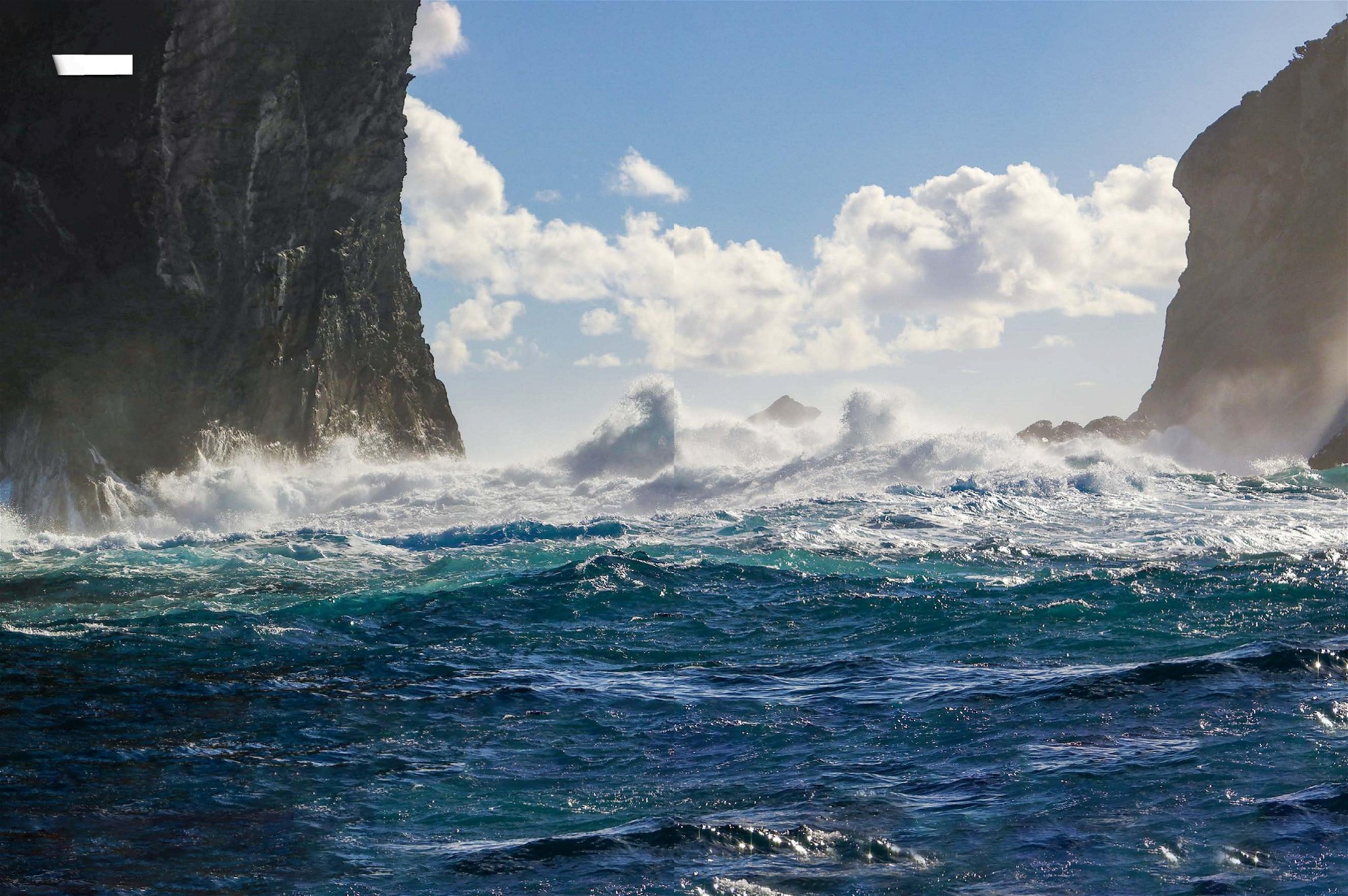
“ AROUND THE ISLANDS, YELLOWTAIL KINGFISH, COMMONLY IN EXCESS OF 30KG, HARASS LOCAL SCHOOLS OF KOHERU, SQUID, MAOMAO, AND TREVALLY. ”
In New Zealand’s Far North, lying approximately 30 miles northwest of Cape Reinga, is one of the world’s most unique, diverse, and attractive destinations for sportfishing enthusiasts. The Three Kings Archipelago is made up of 13 islands that rise out of deep oceanic water to form one incredible, desolate landscape. With currents from both the Tasman Sea and Pacific Ocean sweeping this small island group, it serves as an oasis for a plethora of marine life and sea birds that call this fishing mecca home.

Abel Tasman was the first European explorer to find these islands in 1643. At this stage in history, Tasman noted the islands were inhabited by a group of no more than 100 Māori; however, since 1840 the Three Kings have remained uninhabited. Nowadays, the islands themselves are a wildlife reserve with restricted landing access, governed by New Zealand’s Department of Conservation, forming a pest-free refuge for native animals and plants such as beetles, giant centipedes, skinks, parakeets (kakariki), kanuka and pohutukawa trees, and many more. In the 1940s, the rarest wild plant in the world was discovered on Great Island (the largest island in the archipelago) – a single kaikōmako tree growing on a scree slope inaccessible to browsing goats, earning it the label of “the world’s loneliest tree.” To this day it remains the only known wild specimen, and National Geographic even ran a dedicated feature on it a few years ago.
Like the kaikōmako, much of the wildlife that calls these islands home is unique to the Three Kings thanks to evolutionary isolation. This isolation has also allowed for a marine environment to thrive in almost untouched conditions, providing endless opportunities for adventurous anglers willing to battle the elements in search of a world-class fishing destination.
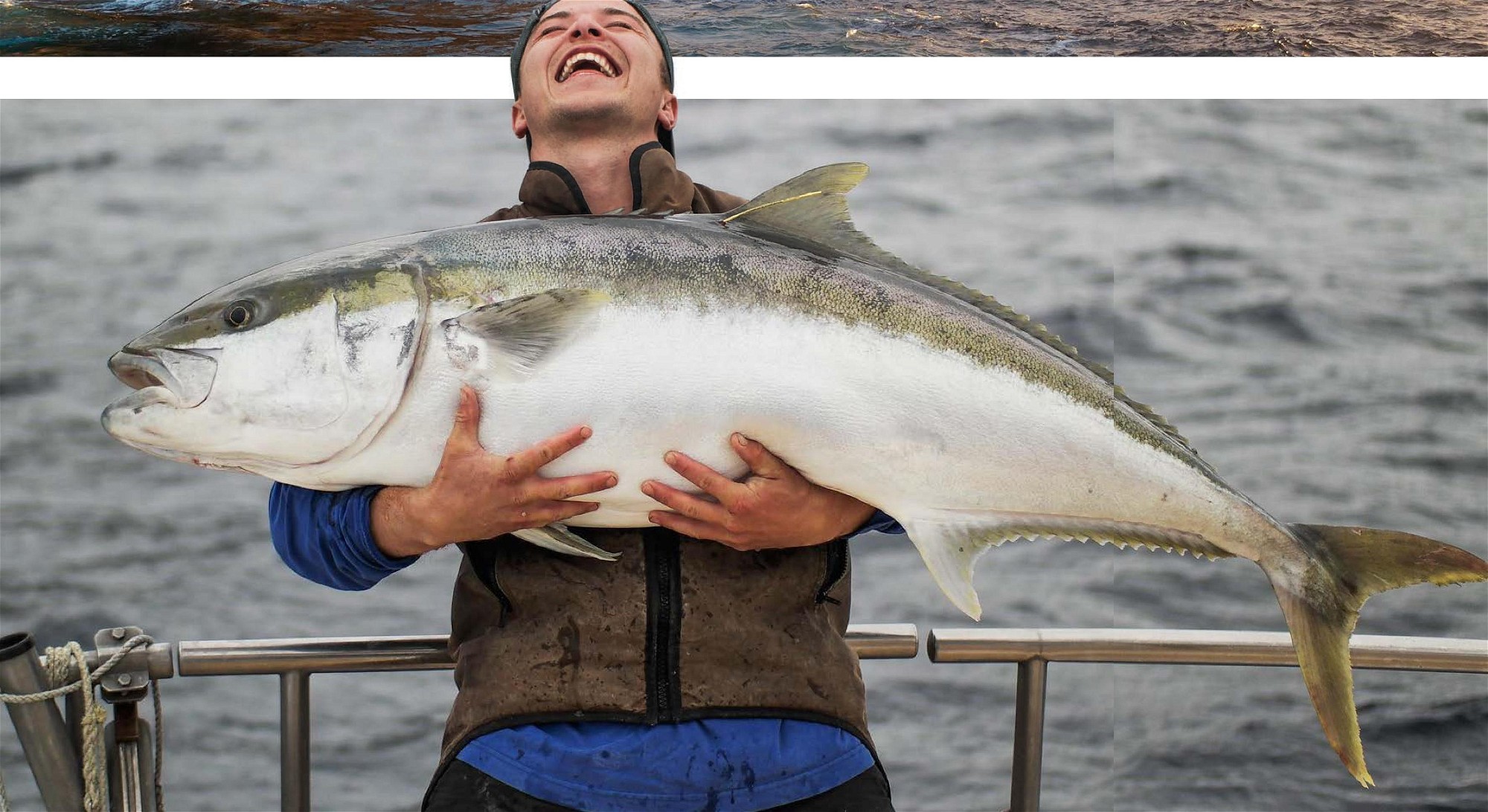
Nutrient-rich water is forced to the surface by deep upwellings around the Three Kings, providing an ecosystem with endless amounts of food for the many species of fish that inhabit these waters. In turn, that means two things: fish life is abundant, and fish grow to incredible sizes. Around the islands, yellowtail kingfish, commonly in excess of 30kg, harass local schools of koheru, squid, maomao, and trevally. Jigging and topwater fishing for these underwater tanks can be extremely successful, with fish often fighting each other to inhale these artificial offerings. Commonly, this is followed by screaming runs, aching arms, and more often than not, disappointment as the fish of a lifetime wins its freedom.
Although lure fishing for these fish can be productive and enjoyable, the most consistent method of catching huge kingfish at the Three Kings is with natural bait – dead or alive. Nights at the Three Kings are often spent catching large arrow squid (up to almost 1m in length), whilst the sunrise session is regularly devoted to fishing for the elusive koheru – the best livebait available in New Zealand waters according to many experienced anglers. With bait sorted, you have the option to fish around the wash of the islands or drift over the endless underwater terrain surrounding the islands.
In order to have a realistic chance at landing the beasts of the Three Kings, heavy tackle is an absolute necessity. Mainline of 80lb breaking strain is the norm, however, many anglers are now starting to use PE10 braid in order to give themselves a realistic chance at taming these thugs of the reef. The fish here are ferocious feeders. I recall several sessions where we drifted dead baits – whole squid and skipjack tuna up to 4kg – to try and persuade bites from the larger specimens. Nevertheless, we were constantly frustrated by fish of no more than 20kg eating our offerings before any serious heavyweights had the chance.
Luckily for us, persistence paid off, and with our ample bait supplies we managed to land more than six kings over the 30kg mark in one afternoon bite, with two true goliaths eclipsing the magical 40kg milestone during the same session. We were pretty chuffed with our efforts until we got to the pub back on the mainland, where the crewman from another charter boat ensured us that the fishing we enjoyed was average. Using the same method of drifting whole dead baits, their crew managed to land at least four fish over 140cm in length, with two of those going over 150cm. These fish weren’t weighed but with dimensions like that, you can only imagine what the scales would’ve been dragged down to.
Although the kingfish are resident yearround and the opportunity to catch a fish over 30kg is present every month, in my opinion, late April to early June seems to be the most consistent period to target the substantial models. As the water temperature cools, the larger fish seem to hit another gear and the quality of fish sharply increases. However, battling with late autumn weather makes the process a little more daunting. Weather windows have a lot to say about where you go and what you do at these times, but a few short lapses in wind are often all that is needed to enjoy sessions on kingfish unmatched almost anywhere else in the world. The kingfish fishing at the Three Kings is certainly world-class, where any bait on any day has a realistic chance at tempting a world record fish – yet it is not the kingfish alone that have anglers from all over the world coming to these waters.
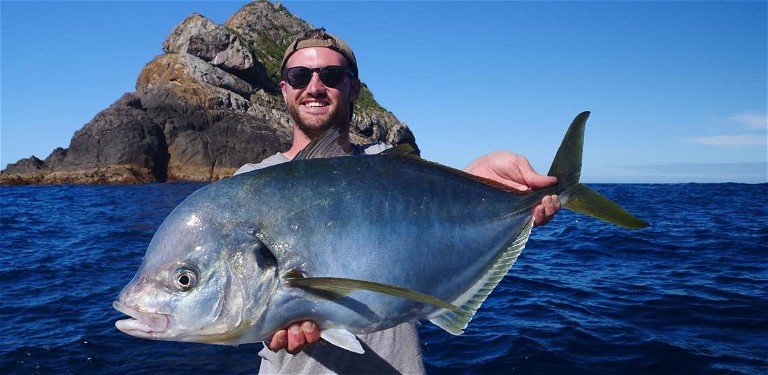
If your arms grow tired from the strain of heavy drag and extended fights with the resident yellowtail population, your attention can shift to the wash rocks and the fish feeding around them. Often giving their presence away with tails and hump heads protruding from the water right on the edge of the whitewash, trevally to 20lb offer another sportfishing opportunity unmatched in New Zealand. Easily tempted with cut baits, soft plastics, microjigs, and flies, these fish provide endless entertainment for anglers, some of which make the trek all the way to these islands purely to test their light tackle skill against these formidable opponents, often enjoying a healthy bycatch of XOS snapper along the way.
Any tide machine, be it a corner, point, or gutter, is a good place to start for these fish, and on days when they can’t be seen, a light berley trail is generally enough to coax these fish to the surface and to start feeding. This provides a unique opportunity to sight-fish these animals, ensuring your time isn’t wasted on smaller models. After the hook-up, you then have to survive the first blistering run which is undoubtedly aimed straight at the reef as the fish makes a determined bid for freedom. In the four seasons I helped guide anglers to the Three Kings on board the nowretired Rick Pollock’s boat Pursuit, we never had a season without breaking a national trevally record. 1, 2, 3 and 4kg men’s line class records were broken on several occasions as well as the 6kg men’s tippet fly record, and on one day we managed four junior NZ line class record trevally, including one epic catch that broke the small fry, junior, and men’s record on 4kg line class – a 6.9kg fish to a 10-year-old angler. As well as providing endless entertainment for light tackle enthusiasts, many days spent fishing the Three Kings end with a plate of beautiful eating sashimi from the fillets of these amazing fish, matched with a cold beer as you ponder over the day’s fishing and the possibilities of the next.

“ TREVALLY TO 20LB OFFER ANOTHER SPORTFISHING OPPORTUNITY UNMATCHED IN NEW ZEALAND. ”
Wide of the islands lie three major underwater banks, which act as a feeding ground for a huge variety of fish species. The King Bank to the north, Middlesex Bank to the west, and the lesser Gobey Bank are each undoubtedly fishing destinations in their own right. Kings, huge hāpuku and bass, and gamefish test angling skills and equipment on these banks, and during the summer months many boats will journey here to fish for the many pelagic species that arrive with the warm currents. Massive striped marlin and yellowfin tuna, along with the occasional black marlin, are often caught atop of the banks, whilst mahimahi, blue marlin, and bigeye tuna are regularly encountered off the edges.
Whether it be lure fishing, tease and switch, or livebaiting, double-figure days on billfish are not unheard of and, thanks to the prevalence of swordfish, the chance of a grand slam is not a completely crazy proposition either. Although it is not something I have achieved, we have gotten very close, and other boats have managed to achieve this milestone fishing these grounds. One example that comes to mind started with us playing a swordfish, estimated at over 200kg. At the 4-hour mark, right on first light, the hooks pulled with the fish being no more than three feet from the waiting gaffs. With daylight upon us, lures were quickly deployed and within a few hours, we had tagged two striped marlin before getting into a three-hour tussle with a 270kg blue which unfortunately died on us but was successfully boated. We then enjoyed a hot session on bass and even managed two modest yellowfin the same day. Whilst generally targeting marlin, over the four seasons I fished the Three Kings, we caught a fair few tuna including yellowfin up to 90kg and bigeye to 100kg, and battled with a northern bluefin – estimated at over 250kg – that won its freedom no more than five metres from the boat at the end of a mammoth seven-hour effort after the huge tuna took a livebait intended for kingfish. Certainly, a story of the one that got away.
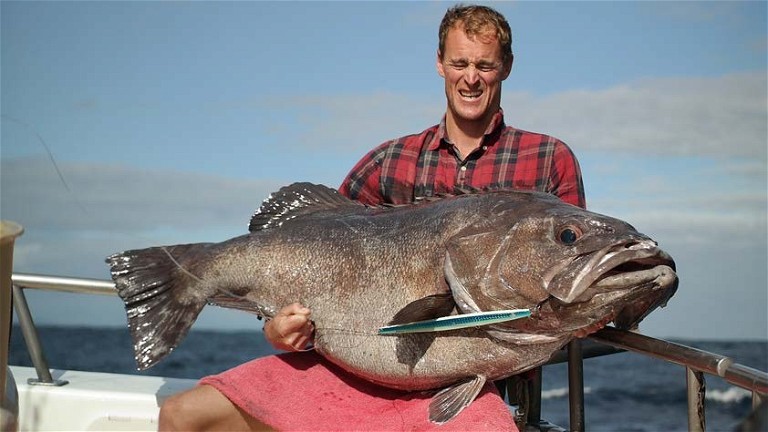
“ KINGS, HUGE HĀPUKU AND BASS, AND GAMEFISH TEST ANGLING SKILLS AND EQUIPMENT ON THESE BANKS. ”
Although a few hardy recreational boats make the trip to the Three Kings, charter boats service these islands through spring, summer and autumn, generally departing from Mangōnui or Whangaroa Harbour. The nearby town of Kerikeri has a domestic airport that provides daily flights to and from Auckland if the idea of a decent drive to the Far North isn’t your cup of tea.
Weather patterns determine the fishing options on some trips and anyone who’s journeyed to these islands knows that it is a ruggedly wild place. This ruggedness, however, is the key to the Three Kings’ abundant wildlife, and should you choose to embrace the elements, world-class sportfishing is there for the taking. Just make sure you bring plenty of tackle… and maybe invite your chiropractor, you’ll need him.
There are several, well-equipped, long-range, live-aboard vessels to take you to these faraway waters. One of those is Demelza, run by Bluewater Adventures. You can check them out here: bluewateradventures.co.nz
